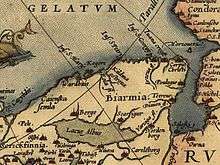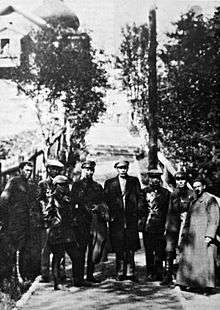Solovki prison camp


The Solovki prison camp (later Solovki prison), located on the Solovetsky Islands in the White Sea, was a large forced labor camp for political prisoners of Imperial Russia, and later the Soviet Union. During the Soviet era, as "Solovki Special Purpose Camp" it became a model where the NKVD developed and tested security measures, "living conditions", work production norms for prisoners, and different methods of repression. The exact number of prisoners who went through the camp during 1923–1939 is still unknown, but estimates range between tens and hundreds of thousands.[1] It was the "mother of the GULAG" according to Aleksandr Solzhenitsyn. He estimated that in 1923 there were "no more than 3,000" prisoners, but that by 1930 the number had jumped to "about 50,000" with another 30,000 imprisoned at the nearby railroad transit point of Kem.[2]
History
Historically, the Solovetsky Islands were the location of the famous Russian Orthodox Solovetsky Monastery complex, which repelled foreign attacks during the Time of Troubles, the Crimean War, and the Russian Civil War.
By Lenin's decree, the monastery buildings were turned into Solovetsky Lager' Osobogo Naznachenia (SLON),[3] that is, the "Solovki Special Purpose Camp". The acronym of the camp name is a sullen word play for those who speak Russian: slon means "elephant". It was one of the first "corrective labor camps", a prototype of the Gulag system.[4] In the beginning of 1924 sometimes the double name was used Severnye (Solovetskiye) Lagerya OGPU (Northern (Solvki) camps of OGPU).[5]

In 1926 the Solovki camp was turned into a prison, partly because of the conditions which made escape near-impossible and partly because the monastery had been used as a political prison by the Russian imperial administration. The treatment of the prisoners attracted much criticism in Western Europe and the USA. After a thorough cleanup, the Soviet government sent the proletarian writer Maxim Gorky to the camp in an attempt to counter this criticism and he wrote a very favourable essay, which praised the beautiful nature of the islands. He is believed by some authors to have understood the real conditions, but the full facts remain a mystery.[6][7]
During the early 1930s many of the prisoners from the camp worked on the notorious White Sea – Baltic Canal.[6] From August 11, 1937, to December 24, 1938, more than 9500 victims of Soviet political repressions were executed by shooting and buried at nearby Sandarmokh. More than 1100 of these were from the Solovki camp.[8]
The prison was closed in 1939 because the Second World War was imminent, while the camp was situated close to the border with Finland. The buildings were then transformed into a naval base. The navy cadet corps was deployed in the monastery buildings, one of the notable cadets was the future author Valentin Pikul.
The Orthodox Church reestablished the monastery in 1992, the year when the ensemble was included into UNESCO's World Heritage List. In 2015 human rights activists accused the authorities of "gradually removing all traces of the labor camp".[9]
Notable prisoners


Many prisoners were members of the intelligentsia, and represent the cream of Tsarist and revolutionary-period Russia. These include:[10]
- Alexander Anisimov (ru:Анисимов, Александр Иванович (искусствовед))- art restoration expert and art historian
- Nikolai Antsiferov – historian
- Vladimir Artemyev – inventor
- Sergei Askoldov (alias S. Alekseev, born Sergei Alekseyevich Kozlov), philosopher and theologian
- Vladimir N. Beneshevich – historian, paleographer
- A.V.Bobrishev-Pushkin – descendant of Decembrist Pavel Sergeievich Bobrishev-Pushkin
- Osip Braz – Russian-Jewish realist painter
- Leonid Feodorov – Bishop and Exarch of the Russian Catholic Church.
- Pavel Alexandrovich Florensky – priest, scientist, encyclopaedist
- Konstantine Gamsakhurdia – Georgian writer
- G.J.Gordon – historian
- A.K.Gorsky – poet
- Archimandrite Illarion (Troitsky, ru:Иларион (Троицкий)) – Professor of the Moscow Theological Academy
- Academician Dmitry Sergeyevich Likhachov – philologist
- Mirjaqip Dulatuli- Kazakh writer
- I.V. Popov – Professor of the Moscow Theological Academy
- Varlam Shalamov – writer
- Vladimir V. Tchernavin – ichthyologist
- H.H.Vinogradov – ethnographer
- Oleg V. Volkov – writer
- M.N.Voronoy – poet
- Jamo bey Hajinski – State Controller and Minister of Transportation, Postal Service and Telegraph of Azerbaijan Democratic Republic
- Nariman bey Narimanbeyov – State Controller of Azerbaijan Democratic Republic
- Hamid bey Shahtakhtinski – Minister of Education and Religious Affairs of Azerbaijan Democratic Republic
- Karlo Štajner - a Yugoslavian communist
Naftaly Frenkel was at first a prisoner, but later became commander of the camp.
Solovki camp in art and literature

- Aleksandr Solzhenitsyn spends an entire chapter of Volume II of The Gulag Archipelago discussing the development of Solovki and the conditions there during the early Soviet regime.[11]
- Vladimir V. Tchernavin was a prisoner in the camp in the early 1930s. He has described his experiences there in his 1934 book I Speak for the Silent Prisoners of the Soviets[12] which he published after his escape abroad.
- The fictional town of Solovets in Monday Begins on Saturday is a hint at Solovetsky Monastery.
- In The Master and Margarita by Mikhail Bulgakov, Ivan Ponyrov (the poet also known as Ivan Homeless) suggests to Woland (a German name for Satan) that Immanuel Kant should be sent to Solovki as punishment for his attempts to prove the existence of God. Woland replies "Thats just the place for him! I told him so that day at breakfast...[However] It is impossible to send him to Solovki for the simple reason that he has resided for the past hundred-odd years in places considerably more remote than Solovki, and, I assure you, it is quite impossible to get him out of there."
- Marina Goldovskaya's 1987 documentary film Solovky Power explores the camp at Solovki and its status as the first of the Soviet labour camps. It features interviews with former prisoners, including D. S. Likhachev.
- Yugoslav communist Karlo Stajner served a part of his sentence in Solovki camp. He described his experiences in his book "7000 days in Siberia" [13]
Footnotes
- ↑ "Forced Labor Camps", on-line exhibition at the Open Society Archives
- ↑ Aleksandr Solzhenitsyn (1975). The Gulag Archipelago. Collins & Harvill Press. p. 72.
- ↑ Соловецкий Лагерь Особого Назначения (СЛОН) (Russian)
- ↑ Gulag by Anne Applebaum. New York: Anchor Book, 2003. p.20.
- ↑ СОЛОВЕЦКИЙ ИТЛ ОГПУ (Соловецкие лагеря особого назначения, Соловецкий лагерь принудительных работ особого назначения ОГПУ, СЛОН, СЛАГ, Соловецкие и Карело-Мурманские лагеря, СКМИТЛ) Memorial (Russian)
- 1 2 Robson, Roy R. (2004). Solovki: The Story of Russia Told Through Its Most Remarkable Islands. Yale University Press. p. 320. ISBN 9780300102703. See pp. 242–243.
- ↑ Yedlin, Tova (1999). Maxim Gorky: A Political Biography. Greenwood Publishing Group. p. 260. ISBN 9780275966058. See p.188.
- ↑ "Sandarmokh"
- ↑ Macfarquhar, Neil (2015-08-30). "A Tug of War Over Gulag History in Russia's North". The New York Times. ISSN 0362-4331. Retrieved 2015-08-31.
- ↑ Application for UNESCO World Heritage Site, 1991, p. 11.
- ↑ Aleksandr Solzhenitsyn (1975). The Gulag Archipelago. Collins & Harvill Press. p. Vol. 2, Part III, Chapter 2.
- ↑ full text (Archive.org)
- ↑ "7000 days in Siberia"
Further reading
- Abraham Ascher, "The Solovki Prisoners, the Mensheviks and the Socialist International", Slavonic and East European Review, vol. 47, no. 109 (July 1969), pp. 423–435.
- Nick Baron, "Production and Terror: The Operation of the Karelian GULAG, 1933–1939", Cahiers du Monde Russe, vol. 43, no. 1 (Jan.-March 2002), pp. 139–180.
- Galina Mikhaĭlovna Ivanova, Carol Apollonio Flath, and Donald J. Raleigh, Labor Camp Socialism: The Gulag in the Soviet Totalitarian System. New York: M.E. Sharpe, 2000.
- Michael Jakobson, Origins of the GULAG: The Soviet Prison Camp System, 1917–1934. Lexington, KY: University Press of Kentucky, 1993.
- Roy P. Robson, Solovki: The Story of Russia Told Through its Most Remarkable Islands. Cambridge, MA: Yale University Press, 2004.
- Vladimir V. Tchernavin, I Speak for the Silent: Prisoners of the Soviets. Boston: Hale, Cushman, and Flint, 1935.
External links
| Wikimedia Commons has media related to Solovki prison camp. |
- Forced Labor Camps, Open Society Archives, www.osa.ceu.hu/
Coordinates: 65°1′28″N 35°42′38″E / 65.02444°N 35.71056°E